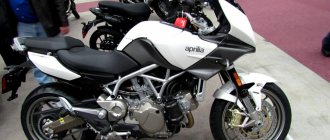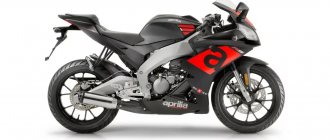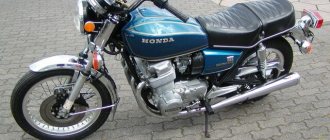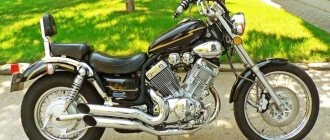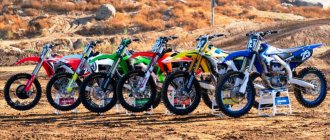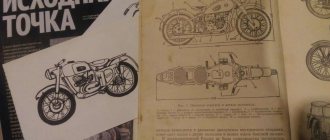Author: Kot shashlik
26 May 2015 09:05
Tags: USSR auto moto motorcycle Soviet motorcycles
43121
14
Motorcycles played a very important role for citizens of the USSR. Often, they were the only opportunity to gain freedom of movement. They rode them to work, on vacation to the seaside, picked up children from the maternity hospital, and took girls for rides in villages.
0
See all photos in the gallery
Modern bikers have switched to foreign-made sportbikes or choppers and are completely unaware of the history of domestic motorcycles. We decided that it was time to stop for a couple of minutes and remember the 10 most popular, most beloved and most popular motorcycles from the distant USSR.
IZ Planet Sport. The fastest and most technologically advanced.
0
In 1973, the Izhevsk Motorcycle Plant surprised the whole country by showing the first Soviet motorcycle with a sports bent, the Planet Sport. Unlike all earlier motorcycles, which were created in the image of German models, Planet Sport clearly tried to be similar to Japanese motorcycles of the 60s and 70s. Due to the high quality of workmanship, IZH Planet Sport was actively sold in export markets, for example, in the UK, the Netherlands and Finland. Soviet bikers accelerated on them up to 140 km/h, which was an incredible speed in those days.
×
What is better - a motorcycle or a car?
When wondering what is better - a classic motorcycle or a car, you should first determine your priorities, determine the boundaries of freedom that you set for yourself. A motorcycle is a vehicle for romantics, thrill-seekers who crave maximum freedom and independence. However, it is immediately worth mentioning that the iron friend is a seasonal mode of transport. You can't ride it in winter. A car is an ordinary tin can, in which you will not feel the wind of freedom, you will not hear the noise of the engine, you will not get caught in the warm summer rain. As always, the choice is up to you - will you seek more freedom or hide behind greater security. The best option for any man is to have both a car and a motorcycle. Moreover, each of them must be chosen with soul, because a person will not get pleasure from those things that he does not like or are unpleasant.
Sunrise. The most rustic.
0
Voskhod motorcycles began to be produced in the city of Kovrov, Vladimir region, in 1957. These were very unpretentious single-cylinder motorcycles (173.7 cm3 engine). The Dyagterev plant constantly improved this model, releasing onto the market after the Voskhod its modernized versions, Voskhod-2, Voskhod-3, Voskhod-3M. The latest Voskhod motorcycle was the 3M-01 model with a 15 hp engine. Because of their reliability, Voskhod motorcycles became real workers in thousands of Soviet villages. Even now you can easily find a Voskhod motorcycle in good condition there.
Autoped
The American one can be considered the parent of modern scooters; it was the first to attempt to create a full-fledged scooter for moving around a big city.
The first prototype of this retro scooter was announced in 1914, and production started in 1916 after a number of improvements were made. The first scooter had a four-stroke engine in its design and had a power of 1.5 hp. The front wheel was driven through a multi-plate clutch.
Weighing only 50 kg, the price of the scooter was one hundred and ten dollars. The composition also included a lighting headlight and a signal. To make it easier to carry the scooter, it was possible to attach the folded handlebars to the rear fender.
After ending scooter production in 1920, Krupp began producing an improved scooter model in Germany in 1921.
M-62. Choice of police.
0
The Soviet police, fair and incorruptible, in the 50s-60s mostly traveled on motorcycles with sidecars. The M-62, produced by the Irbit Motorcycle Plant, was the most popular choice of servants of the law. Its four-stroke engine produced 28 hp. An interesting fact is that ordinary citizens of the USSR were not allowed to operate Urals without a sidecar at that time. Still, these motorcycles were quite difficult to control. But the police used motorcycles without sidecars, which looked very cool in the eyes of Soviet boys. How can you not want to become a policeman!
Prices
Prices, of course, vary greatly: it all depends on the cubic capacity, year of manufacture and mileage of the motorcycle. The most popular here are the Japanese “400”, which, depending on wear and tear, can be bought for $2,500 - $5,000. But you will get tired of such a motorcycle after a year, because it is a rather boring machine. Then, depending on the volume, the price also increases. But in principle, you can buy good liter motorcycles cheaply, but you need to either do it through friends or know how to choose them. That is, you can buy a liter motorcycle for five thousand dollars, and it will run fine for another ten years.
YOU CAN BUY A LITER MOTORCYCLE FOR FIVE THOUSAND DOLLARS, AND IT WILL RIDE NORMALLY FOR ANOTHER TEN YEARS. |
Tula-200. For hunters and fishermen.
0
The Soviet motorcycle industry did not produce ATVs (some small-scale models, however, were still produced, read below), but for the needs of hunters and fishermen, a very unusual Tula-200 motorcycle with wide off-road wheels was produced. The mass distribution of such motorcycles occurred in 1986-1988. The engine was taken from the Tulitsa motor scooter, increasing its power to 13 hp. This made it possible to accelerate at 200k to 90 km/h. 10-12 thousand of these bikes were produced per year, the last of which rolled off the plant’s assembly line in 1996. By the way, they even produced a trike based on the Tula-200!
Moto Guzzi V7 III
The classic V7 has been in the model range of the Italian company Moto Guzzi for more than 50 years. The last major update took place last year: the 750 cc engine increased power and began to comply with Euro-4 standards, and ABS and proprietary track control began to be installed on the motorcycle by default. The V7 has an excellent chassis that allows even a novice driver to feel confident behind the wheel and enjoy cornering. Also a plus will be a large 21-liter tank and a cardan drive, which will require less frequent maintenance from you.
IZH-49. The most durable.
0
Reliable, durable, beautiful. The sound of its engine for the Soviet ear was akin to the sound of a Harley-Davidson engine for Americans. Their production began in 1951. At its core, it was an improved design of the German motorcycle DKW NZ 350. IZH-49 won great love among the population and was used in all corners of the vast Soviet Union. On its basis, versions with a sidecar were produced, as well as sports motorcycles for cross-country and road racing. Now IZH-49 is a collector's item. Prices for them start from 100 thousand rubles.
Tips for caring for a classic motorcycle
It’s not easy with a motorcycle, just like with a car, and perhaps even more difficult. You need to take care of this type of equipment very carefully. The motorcycle cannot be left in the open sun, in the rain, in the cold, etc. This means that it definitely needs a garage. In addition, each modern motorcycle is demanding in its own way when it comes to fuel - it must be clean and have a high octane number. All technical components of the motorcycle must be constantly lubricated and kept clean.
The main attention should be paid to the brake systems, they should always be clean and in working order. In addition to the brakes, pay attention to the condition and lubrication of the chain - constantly check its tension, check the play and the condition of the wheel bearings. All these components are very important, since your life and health depend on their serviceability.
M-1A "Moscow". The first post-war.
0
After the war, the Moscow Bicycle Plant began producing a copy of the German DKW RT125 motorcycle with a 125 cc engine. M-1A "Moscow" became the first post-war motorcycle of the USSR. It was a simple and lightweight motorcycle that did not require much metal or rubber to produce. Such motorcycles were used in huge quantities to train motorcyclists in DOSAAF schools. Perhaps your grandfather studied just like this. In 1951, production was transferred to Minsk to a bicycle factory built there. An almost identical model was produced in Kovrov under the designation K-125.
Classic will never die
As they say, a classic never dies - it's true. This expression applies to everything, including motorcycles. Developed in the 60-80s, iron horses remain popular and beloved to this day. Road classic motorcycles of that time are in demand, despite their age, and the value of such equipment is growing every year before our eyes. Classics lovers all over the world are chasing some exclusive models and trying to reconstruct dying species.
With all this, it is worth saying that almost all modern manufacturers, in addition to producing modern types of motorcycles, also produce classic iron horses. They make a huge contribution to keeping this species afloat. This is why road classic motorcycles will never die in people's minds. At least, this will be the case until they come up with something more modern and original.
Jawa 360. The most beautiful.
1
In the 70s, every third motorcyclist rode in Java. In total, more than 1 million Jawa motorcycles of various models were delivered to the USSR, but the 360 was the most beautiful of all. Nowadays, cherry-colored motorcycles with chrome-plated gas tanks are called “Old Lady.” Particularly valuable are specimens with a side stroller made of fiberglass. Versions were produced with a 1-cylinder engine (250/260) or with a 2-cylinder engine (350/360). By the way, Java often appeared in various films. For example, it is on the Jawa 360 that Gesha Kozodoev takes Semyon Semenovich Gorbunkov fishing on the White Rock in the film The Diamond Arm.
Triumph Bonneville Bobber
Bobber as a class of custom motorcycles originated in the USA. Previously, these were racing motorcycles for every day: the owner came to a race on a dirt track, took part in it and returned home under his own power. In order for the road bike to be effective during the race, the wings were significantly shortened, the handlebars were low and straight, and all unnecessary elements were removed to reduce weight. The new Bonneville Bobber comes as close as possible to this image. A well-hidden rear shock absorber makes the frame's silhouette look swift, and the saddle floating above it and the rear fender adds visual lightness. The model has a classic in-line 2-cylinder engine for the British brand, which is closer in behavior to a V-twin. Peak torque is already at 4000 rpm, maximum power is 76 hp. With.
Photo: Press materials
Jawa 350/638. Motorcycle of the roaring 90s.
0
The last of the Jawas sold in the USSR, Jawa 350 638, also became a “people's” motorcycle. Having managed to come out just before perestroika, in 1984, this model often appeared in harsh films of the late 1980s and early 1990s. Thus, “Java 350 638” can be seen in the drama “Accident - the Cop’s Daughter” and the action film “Rats, or the Night Mafia.” There is even a song “Java” dedicated to the motorcycle by the popular group “Sector Gaza” in those years.
Vyatka VP-150. Italian elegance.
0
The last one in our review is not a motorcycle at all, but a scooter. The Vyatka VP-150, the prototype of which was the Italian Vespa scooter, is rightfully considered the most elegant two-wheeled vehicle in the USSR. It was a quiet and very comfortable scooter that even women could drive with ease. At the Vyatka base they made a whole range of three-wheeled scooters with various bodies, which were actively used in urban cargo transportation.
The perfect neo-retro bike for your body type
As silly as it may sound, choosing the right neo-retro motorcycle
does not occur with a heartbeat. Your body type, or more specifically your height and weight, plays a big role in your purchasing decision. When your two-wheeler is stationary, your feet should be level. This is important to properly control the weight of the car and keep it stable throughout the trip (a safety issue).
Pilot morphology is a selection criterion that cannot be neglected. If you are not strong enough and strong enough, then you have your sights set on a neo-retro motorcycle
heavy, you risk seeing a nightmare with every maneuver in slow motion. On the other hand, if you are the size of a professional basketball player, you should rule out models that give the impression and feeling of riding with your knees in your teeth.
BONUS! 11. Riga-13. The first moped of Soviet boys.
0
Riga began producing mopeds back in 1958. Many boys dreamed that their parents would give them a moped for their birthday. This is what they did, so mopeds, and especially Riga-13, became the first vehicle for many. Riga-13 began to be produced in 1983. Equipped with a 1.3 hp engine, it accelerated to only 40 km/h. To start from a standstill and move uphill, the “biker” was recommended to help the engine by rotating the pedals. Riga-13 was produced until 1998, becoming the most popular model. A truck for everyone.
0
Based on the Tula scooters, the Tula Machine-Building Plant produced a huge number of three-wheeled cargo scooters called Ant. This was a breakthrough for the Soviet Union, because the sale of vans and station wagons to USSR citizens was prohibited. So such scooters were almost the only opportunity to transport small quantities of cargo. TMZ has produced a huge number of such scooters. They were equipped with flatbed platforms, dump bodies, vans and even tanks. They are still popular today.
Where can I buy
| There are two main motorcycle markets: Japan and America, and they are very different from each other. Within the Japanese market, there are motorcycles that are very popular here - these are different four-hundred-cc versions, they are simply cheaper, but they are not made for America, they are sold only in Japan and carried only by those dealers who deal in Japanese motorcycles. All this can be bought in large offices, like Soyuz Moto, NBS Moto and so on - wherever they deal in used motorcycles. |
And the second main market is the American one, it has its own differences, its own culture. Well, there are also companies that deal with purely American motorcycles: for example, MotoTorg.
With custom motorcycles, the story is a little different: now small companies are already appearing in both Japan and America that create mini-production of custom bikes. All large companies that work with these markets can hypothetically bring their products here on order. That is, you just need to go there and say that I need such and such a specific motorcycle, and they will bring it to you, but it will most likely cost additional money, because this is not their main profile and, accordingly, an extra hassle.

